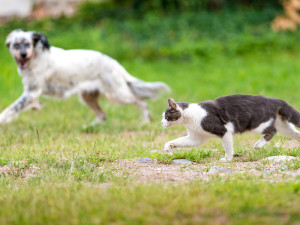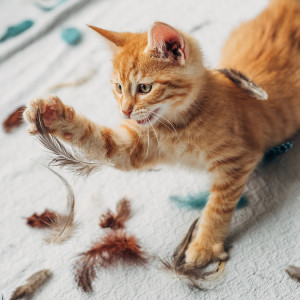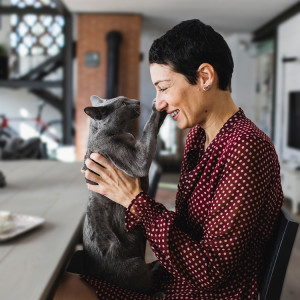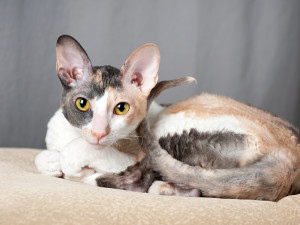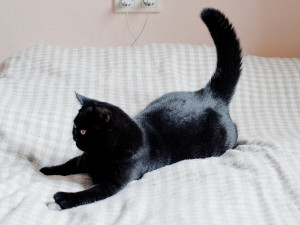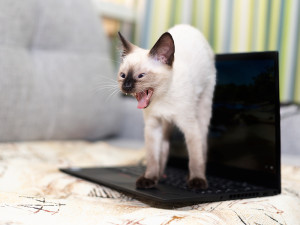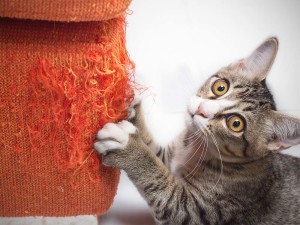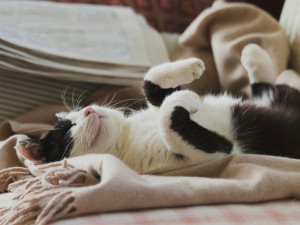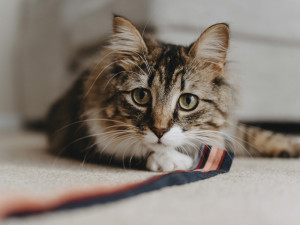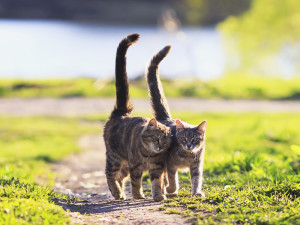How High Can Cats Jump?
Cats can jump much higher than you might think.
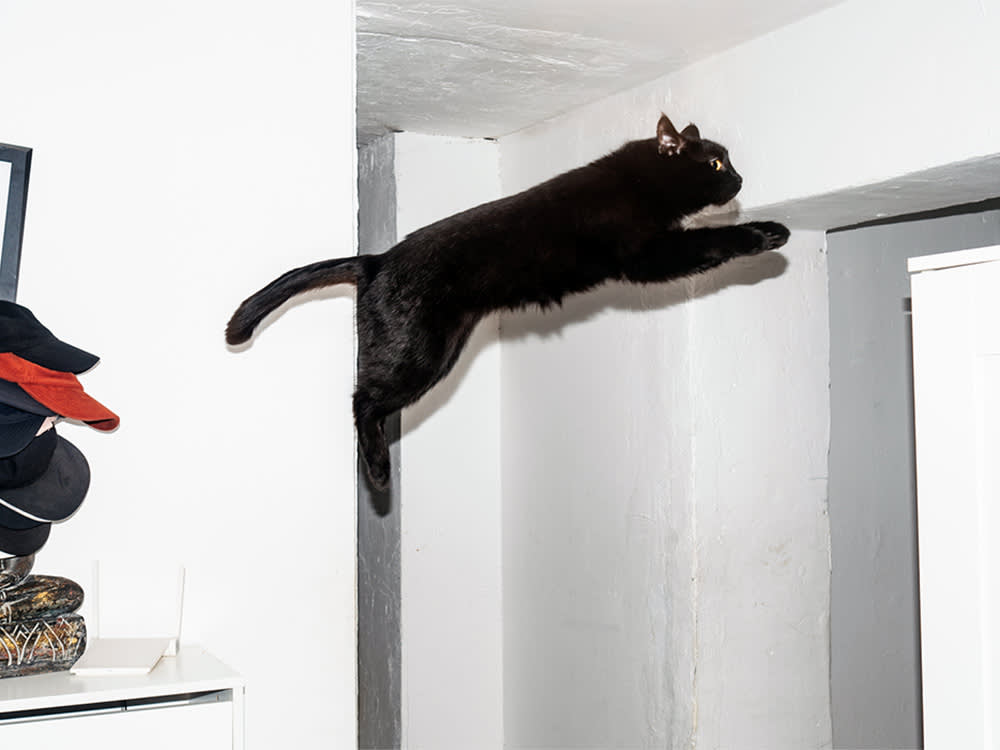
Share Article
In this Article:
A Cat’s Vertical Jump Height Why Can Cats Jump So High? Contributing Physical Factors Breed Impacts on Jumping Ability High Jump Risks Frequently Asked Questions
Cats can jump much higher than you might think. Depending on whether they begin their jump running or standing, your cat can jump at least eight feet in the air.
How high can cats jump?
Cats do all sorts of weird and wild things, but their jumping skills might just be one of the most notable.It’s not uncommon for them to leap up to nine times their heightopens in new tab. Many cats don’t even need a running start to soar; they can jump eight feet from a standing position.

Why can cats jump so high?
Think your cat is all catnaps, headbutts, and purrs? Think again. Your loafin’ feline is actually a fierce predator who stalks their next meal at dusk and dawn. They’re also prey for larger animals like coyotes, eagles, and foxes.
OK, OK, your cat isn’t going to get eaten by a hawk, and they might even get white-glove table service, but they do retain all the necessary adaptations to catch their next meal and safely escape the claws of predators. With powerful back legs propelling them eight or more feet off the ground, they put these skills to good use in everyday tasks, like play, exploration, and (sometimes) swiping food from the counter.
Contributing physical factors
Cats are built for agility, says Dr. Colleen Lamboopens in new tab, a veterinarian at the mobile veterinary service The Vetsopens in new tab. According to her, here are some physiological features that make them so nimble:
Powerful hind limbs: Cats’ back legs have powerful muscles designed for explosive bursts of energy. “Particularly the quadriceps and gastrocnemius contribute to the force generated during a jump,” Dr. Lambo tells Kinship.
Flexible spine: Cats have a more flexible spine than many other animals, allowing them to twist, contort, and arch their backs to fully extend their hind limbs and even adjust in midair for precise landings.
Elastic tendons and ligaments: Stretchier tendons and ligaments efficiently store and release energy during jumps for a quick and powerful launch.
Strong core muscles: A strong core stabilizes the body during a jump.
Long limbs: Cats’ back legs are relatively long compared to their body size, which provides an advantageous lever system for generating force. (And you thought physics class a waste)
Retractable claws: Cats’ claws act as little spikes to gain traction during takeoff and landing.
Excellent depth perception: Feline eyesight is pretty wild. They have the ability to accurately gauge distances by sight. Cats’ superciliary (above the eye) whiskers, mandibular (muzzle) whiskers, and carpal (wrist) whiskers act like little antennas and built-in measuring tapes, enhancing this precision.
Specialized toes: Have you noticed that, unlike humans who walk on their heels, cats walk on their toes? Called digitigrade locomotionopens in new tab, it gives them a spring-like leap.
Shock absorbers: “The tarsal (ankle) bones act as shock absorbers, enhancing their ability to absorb the impact of landing,” Dr. Lambo explains.
Breed impacts on jumping ability
A cat’s jumping ability is more about their physical limitations and health than their breed since they're all made with the same stuff. That said, Dr. Lambo says there are few particular breeds known for their muscular physique and overall athleticism, including:
Abyssinian
Bengal
Savannah
Oriental Shorthair
Siamese
Cornish Rex
Devon Rex
Maine Coon
There isn’t a Guinness World Record for the highest vertical jump but Waffle the Warrior Catopens in new tab (a tuxedo kitty resembling none of the aforementioned breeds) holds the record for the longest vertical jump at seven feet. Meanwhile, Savannah cats are said to be able to jump over ten feet, and if you’re wondering how high a Bengal cat can jump, they can leap as high as 8 feet.
Short-legged feline friends, such as Munchkins or those prone to arthritis or genetic disorders such as Scottish Folds, typically don’t reach such great heights.
Risks of high jumps
There isn’t a defined limit to how high cats can jump down. And stories of cats falling from buildings and landing on their feet (thanks to the righting reflex) may leave you believing that great heights are no feat for cats.
But cats don’t always land on their feet. Even if they do, many suffer injuries like bone fracturesopens in new tab. The risks can increase when jumping to or from unsafe or unsteady surfaces, especially for cats with health conditions or injuries, or if your cat is a senior. A good rule of thumb is to provide plenty of safe jumping surfaces, such as sturdy cat trees and cat shelving with non-slip surfaces.
“For senior cats, especially those with age-related changes in mobility or health conditions, it’s essential to consider safety precautions when it comes to jumping activities,” Dr. Lambos says. She offers the following tips for encouraging safe play and exercise:
No matter your cat’s age, maintain a healthy weight to reduce stress on joints. Your veterinarian can help you establish a diet and feeding plan tailored to your cat.
Opt for low-impact activities that are easy on the joints, like gentle play with soft toys, slow-paced interactive games, or short walks if your cat enjoys being on a leash.
Create easily accessible elevated spaces, such as low platforms or padded perches. Consider using pet stairs or ramps to make higher areas more accessible.
Place soft, cushioned surfaces around areas where your cat likes to jump to help reduce the impact on joints and provide a comfortable landing surface.
Even if your cat seems healthy, don’t skip regular veterinary check-ups. “Early detection and management of conditions like arthritis can significantly improve a cat’s quality of life,” Dr. Lambos says.
FAQs (People also ask):
Is there a world record for the highest cat?
There’s no Guinness World Record for the highest vertical jump by a cat but the title for longest horizontal jump goes to Waffle the Warrior Catopens in new tab. He’s a 10-year-old tuxedo with a mighty seven-foot leap.
Can a cat jump seven feet?
Most domestic house cats can vertically jump nine times their height, which averages about eight feet from a standing position! Some cat breeds, like Savannah cats, can even jump to remarkable heights over 10 feet. Older cats and those with genetic conditions may keep all four paws closer to the ground.
How can I keep my cat safe when jumping?
Jumping, climbing, and pouncing are all natural behaviors of a cat and a great way for them to exercise. Provide your cat with plenty of safe jumping surfaces, such as sturdy cat trees and shelves with traction. If you’re worried about your cat jumping down from high spots, Dr. Lambos recommends padding the landing zone with soft surfaces. To ensure your senior cat can still access their favorite perch, consider offering pet stairs or a ramp.
Do cats always land on their feet?
Cats don’t always land on their feet, but they do have something called the “righting reflex” which allows them to twist their body during a fall to land on their feet most of the time. But if they fall from too low of a height, they may not have enough time to contort their bodies. Falling from too great of a height can still result in injuries even if the cat makes a near-perfect landing.
References:

Janelle Leeson
Janelle Leeson is a Portland, Oregon-based freelance writer. Her work has been featured in magazines such as Inside Your Dog’s Mind, Inside Your Cat’s Mind, Paw Print, and Real Simple, and on Adopt-A-Pet, Insider Reviews, Forbes Vetted, Forbes Advisor, Readers Digest, NBC Select, Shop Today, PetMD, Chewy Education, Spruce Pets, Daily Paws, and The Bump.
She is a three-time certificate of excellence winner (via the Cat Writers’ Association) and is a two-time panelist at the American Society of Journalists and Authors annual conference. Her work focuses on pet behavior, general care, and nutrition, pet product testing and buying guides, exotic pet behavior, general care, and nutrition, parenting product testing and buying guides.
Related articles
![black cat doing zoomies on a bed]()
Your Cat’s Erratic Zoomies — Explained
Fast, furious, and officially normal — according to a cat behaviorist.
![An angry and hissing Siamese kitten standing on top of a laptop computer in the living room]()
You Don’t Have to Live Like This—You Can Get a Trainer For Your Cat
Tips to help you find a legit behaviorist (according to a veterinary behaviorist).
![Kitten scratching fabric sofa]()
How to Stop Your Cat From Absolutely Ripping Apart Your Couch
Placing a cat tree or post in a room only, uh, scratches the surface of solving this problem.
![Black and White cat with its eyes closed laying on its back on a scarf]()
Is My Cat Happy?
In this excerpt from her new book, Purr: The Science of Making Your Cat Happy, animal behaviorist Zazie Todd shares science-backed insights into our cats’ moods.
![A cute cat laying on the ground with wide eyes]()
Why Do Cats Slow Blink?
Here’s what your cat’s favorite move means.
![Two cats walking with their tails sticking straight up]()
Cat Tail Meanings
Cats are enigmas. But their tail movements can reveal a lot about their moods.

